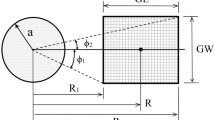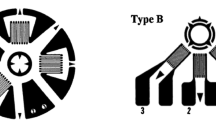The hole-drilling strain-gauge method is a common residual stress evaluation approach, where the calibration coefficients are one of the main factors affecting their measurement accuracy. However, those coefficients are the constant value for ASTM E837-13a, Standard Test Method for Determining Residual Stresses by the Hole-Drilling Strain-Gauge Method, which does not allow for the Poisson’s ratio effect. The finite element method to calculate the calibration coefficients was first proposed, then the Poisson’s ratio effect on them was studied. The results show that the calibration coefficients \( {\overline{a}}_{jk} \) increase and \( {\overline{b}}_{jk} \) decrease with Poisson’s ratio exhibiting a good linear relationship. The Poisson’s ratio correction factor was introduced to calculate calibration coefficients for any Poisson’s ratio, those values (v0) offer an improvement in the versatility of a given calibration coefficient. The problem of the Poisson’s ratio effect on the calibration coefficients was solved, and their accuracy was improved due to the use of the hole-drilling strain-gauge method.







Similar content being viewed by others
References
G. Totten, M. Howes, and T. Inoue, Handbook of Residual Stress and Deformation of Steel, ASM International, Materials Park, OH (2002).
M. Shokrieh, Residual Stresses in Composite Materials, Woodhead Publishing Ltd., Cambridge (2014).
J. Lee, G. Park, C. Park, and H. Kim, “Enhanced ferroelectric properties of Pb(Zr,Ti)O3 films by inducing permanent compressive stress,” Appl. Phys. Lett., 88, No. 7, 072908 (2006).
Z. Wu, J. Zhou, W. Chen, et al. “Effects of residual stress on the electrical properties in PbZr0.52Ti0.48O3 thin films,” J. Sol-Gel Sci. Techn., 75, No. 3, 551–556 (2015).
G. S. Schajer, Practical Residual Stress Measurement Methods, John Wiley & Sons, West Sussex (2013).
G. S. Schajer, “Hole-drilling residual stress measurements at 75: Origins, advances, opportunities,” Exp. Mech., 50, No. 2, 245–253 (2010).
G. S. Schajer, “Measurement of non-uniform residual stresses using the hole-drilling method. Part I – Stress calculation procedures,” J. Eng. Mater. Technol., 110, 338–343 (1988).
G. S. Schajer, “Measurement of non-uniform residual stresses using the hole-drilling method. Part II – Practical application of the integral method,” J. Eng. Mater. Technol., 110, 344–349 (1988).
ASTM E837-13a, Standard Test Method for Determining Residual Stresses by the Hole-Drilling Strain-Gage Method, ASTM International, West Conshohocken, PA, 2013
GB/T 31310-2014, Metallic Material – Determination of Residual Stress – Hole Drilling Strain-Gauge Method, Standards Press of China, Beijing (2014).
M. Sebastiani, T. Sui, and A. M. Korsunsky, “Residual stress evaluation at the micro- and nano-scale: Recent advancements of measurement techniques, validation through modelling, and future challenges,” Mater. Design, 118, 204–206 (2017).
A. J. G. Lunt and A. M. Korsunsky, “A review of micro-scale focused ion beam milling and digital image correlation analysis for residual stress evaluation and error estimation,” Surf. Coat. Tech., 283, 373–388 (2015).
J. Everaerts, X. Song, B. Nagarajan, and A. M. Korsunsky, “Evaluation of macro- and microscopic residual stresses in laser shock-peened titanium alloy by FIB-DIC ring-core milling with different core diameters,” Surf. Coat. Tech., 349, 719–724 (2018).
J. Everaerts, E. Salvati, F. Uzun, et al., “Separating macro- (type I) and micro- (type II+III) residual stresses by ring-core FIB-DIC milling and eigenstrain modelling of a plastically bent titanium alloy bar,” Acta Mater., 156, 43–51 (2018).
T. Rickert, “Residual stress measurement by ESPI hole-drilling,” Proc. CIRP, 45, 203–206 (2016).
F. Archie, M. Z. Mughal, M. Sebastiani, et al., “Anisotropic distribution of the micro residual stresses in lath martensite revealed by FIB ring-core milling technique,” Acta. Mater., 150, 327–338 (2018).
V. Pisarev, I. Odintsev, S. Eleonsky, and A. Apalkov, “Residual stress determination by optical interferometric measurements of hole diameter increments,” Opt. Laser. Eng., 110, 437–456 (2018).
C. Lu, Residual Stress Measurement Hole-Drilling Method [in Chinese], Xi ‘an Jiaotong University Press, Xi’an (1991).
Author information
Authors and Affiliations
Corresponding author
Additional information
Translated from Problemy Prochnosti, No. 4, pp. 44 – 50, July – August, 2021.
Rights and permissions
About this article
Cite this article
Pan, L., Ge, H. & Wang, B. Effects of Poisson’s Ratio on the Calibration Coefficients of Hole-Drilling Strain-Gauge Method for Measuring Residual Stresses. Strength Mater 53, 566–572 (2021). https://doi.org/10.1007/s11223-021-00318-7
Received:
Published:
Issue Date:
DOI: https://doi.org/10.1007/s11223-021-00318-7




